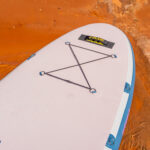Glide O2 Retro 3.0' iSUP
Pros
- Full length deck pad great for SUP yoga, fitness, or pets
- Included Inflatable AirThrone kayak conversion seat
- Stable well balanced board all around
- Heavy duty PVC + high PSI rating makes for a very durable inflatable SUP
- Removable, tool-less side fins
Cons
- Listed max PSI rating of 25 is too high - we recommend keeping this at 15-20 PSI
- The Retro 3.0 includes a great kayak seat, but still needs an extra paddle blade (sold separately) for a complete kayak conversion.
Glide have given their popular O2 Retro a complete, ground-up, makeover, and we reckon they’ve made it even better…

The O2 Retro 3.0 is the latest version of the best selling paddleboard in Glide’s inflatable range. The shape is unchanged from the previous version but the construction has been completely upgraded, the fin configuration changed and some extra fittings have been added.
We really rated the previous version of the O2 Retro, so we were excited to get our hands onto the Retro 3.0, especially when we heard that the new construction was both lighter and stiffer. In this review we’ll tell you what we found when we got the Glide O2 Retro 3.0 out onto the water.
Let’s start by setting the scene. 10’6 has become an industry standard size for the classic entry-level paddleboard . It’s still short enough to be light in feel and relatively maneuverable, yet stable enough to work as a general purpose all rounder, even for beginners. So this is a very busy segment of the market, with a vast array of designs on offer.
Glide have clearly thought hard about how to make their O2 Retro stand out from the crowd, and we’re not just talking about the eye-catching ‘retro’ color-scheme! The board’s design has a few differences which definitely give it an edge in many aspects of performance, as we’ll detail in this review.
We think the Glide O2 Retro 3.0 would be a great SUP for paddlers who:
- Want an all-round general purpose board with an extra helping of stability
- Like the idea of the kayak option
- Appreciate the full deck pad, giving the board that yoga/fitness comfort and capability
- Enjoy a board with a lively purposeful feel and a decent turn of pace, but still very suitable for beginners and messing around on.
Glide O2 Retro 3.0: Spec Sheet
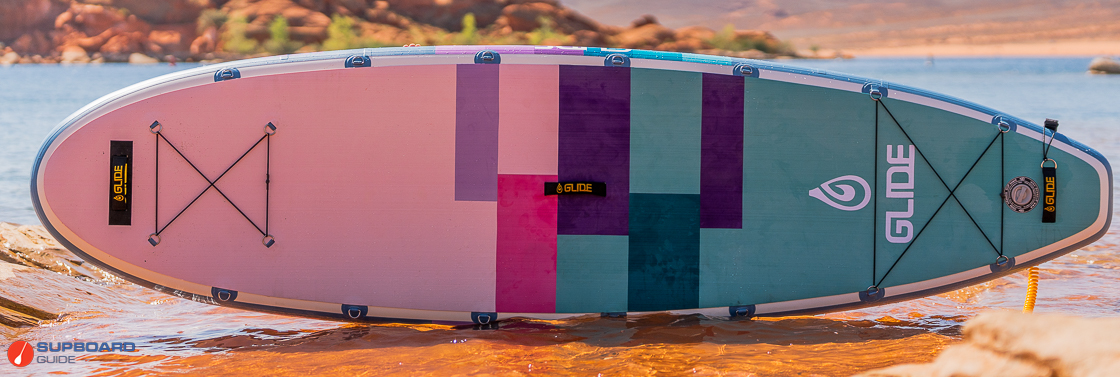
- Board Category:
- Listed Board Dimensions: 10’6” long, 33.5” wide, 6” thick
- Measured Board Dimensions: 10’6” long, 33.5” wide, 6” thick
- Listed Board Weight: 20 lbs
- Actual Board Weight (board only, not inflated): 21.8 lbs
- Listed Max Capacity: 400 lbs
- Recommended PSI: 15-25 PSI
- Fins: 9” US-box center fin + 2 4.5” fliplock fins
- Paddle: 3 piece composite with nylon blade
- Board Shell Construction Materials: Dual layer fusion PVC
- Drop-stitch type: Cross-knit woven drop stitch
- Price Range: $699
- Warranty: 10 years
Performance Review of the Glide O2 Retro 3.0 Stand Up Paddle Board
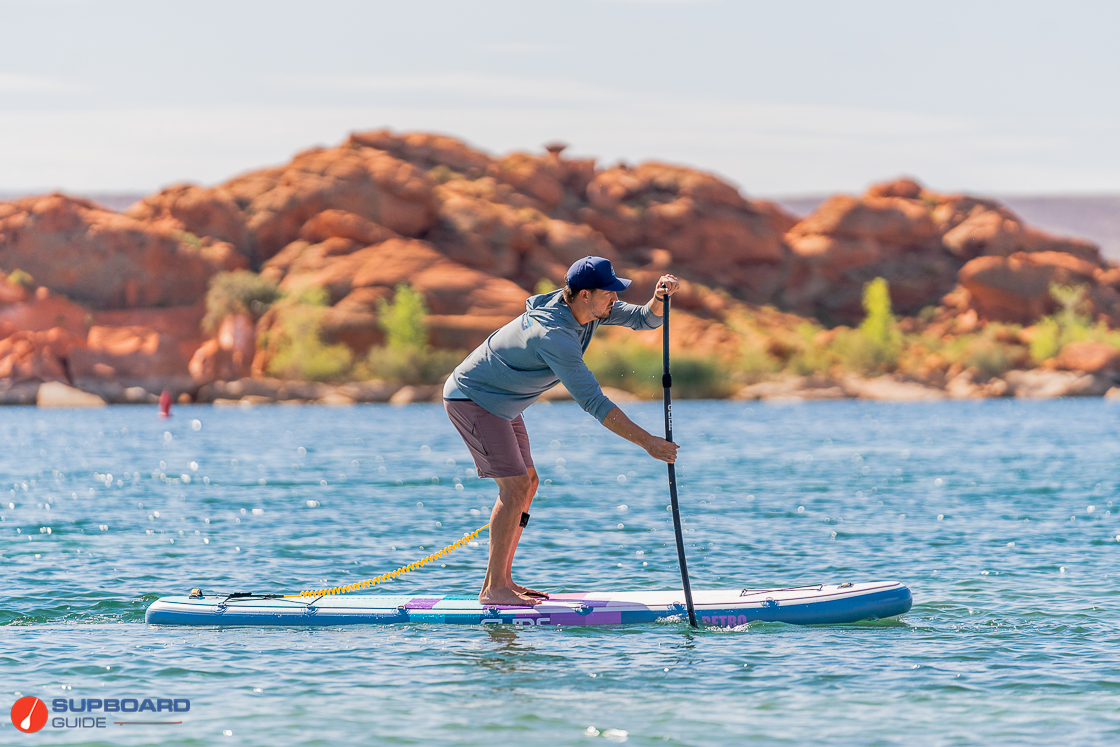
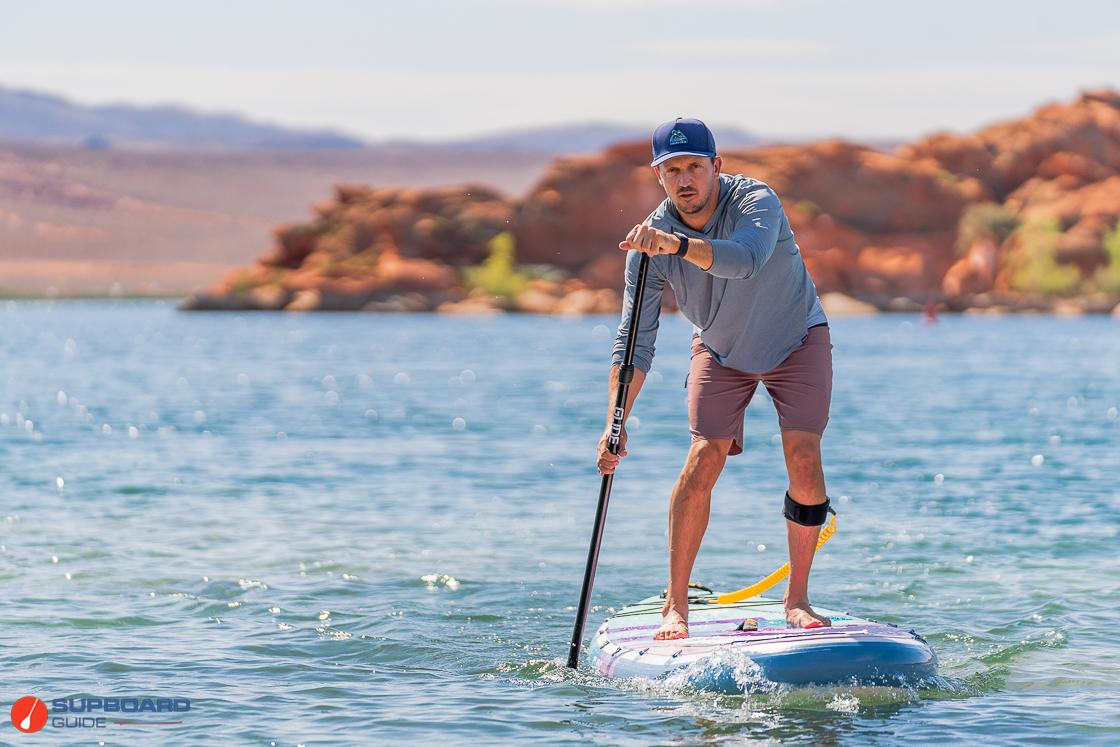
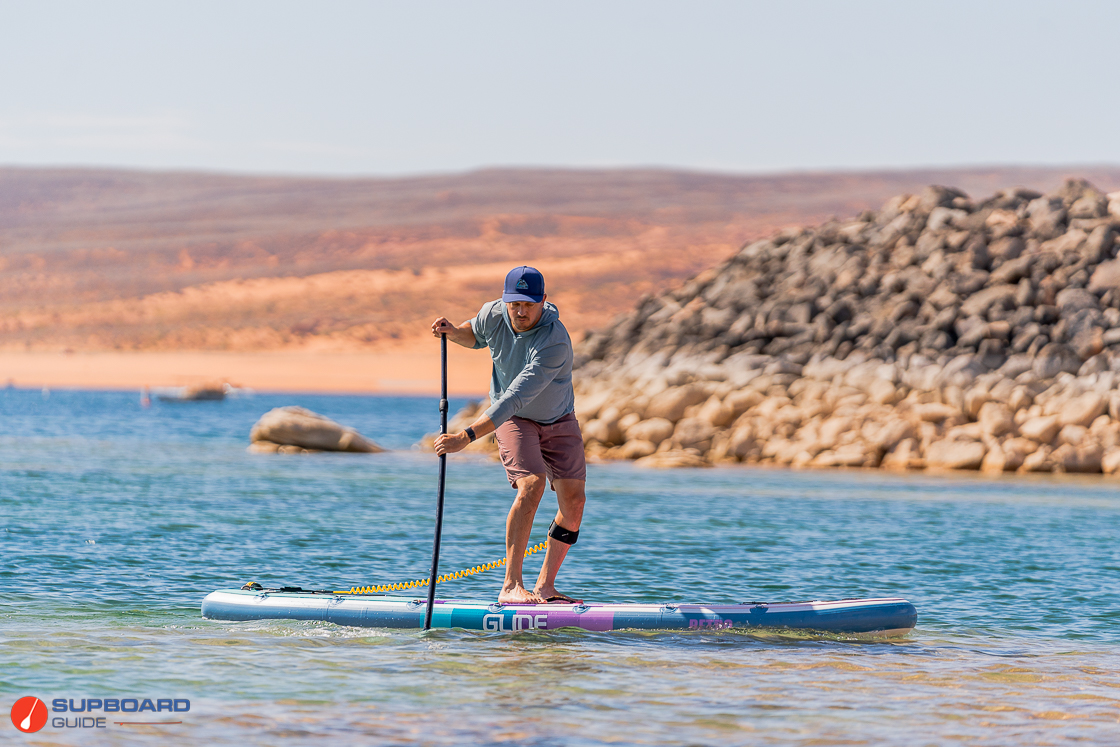
Overall Score: 9.2/10
- Stability: 9.2/10
- Speed: 8.7/10
- Tracking: 9.1/10
- Maneuverability: 8.8/10
- Construction Quality: 9.4/10
- Features/Accessories: 9.0/10
Stability Rating: 9.2/10
With nearly 34” of width, we expected the Glide 02 Retro 3.0 to offer a reasonable amount of stability. However, we were pleasantly surprised to find that it actually exceeded expectations in this respect. Glide has pulled off a very clever trick with the plan shape of the O2 Retro 3.0.
Normally we find that when a board has a pulled-in tail, as is very much the case with the O2 Retro 3.0, the lack of ‘hips’ in the plan shape takes quite a noticeable toll on the stability.
However, Glide have managed to negate this by keeping plenty of width at the back of the main standing/seating area, so the taper towards the tail doesn’t start until quite a long way back along the board. They’ve also left a whole lot of width up front; the maximum width in the center area extends a very long way forward, right into the nose.
The end result is a very stable platform, aided further by the relatively flat rocker profile, which ensures that the vast majority of this surface area is in contact with the water to maximize the stability. The three large fins in the tail also contribute.
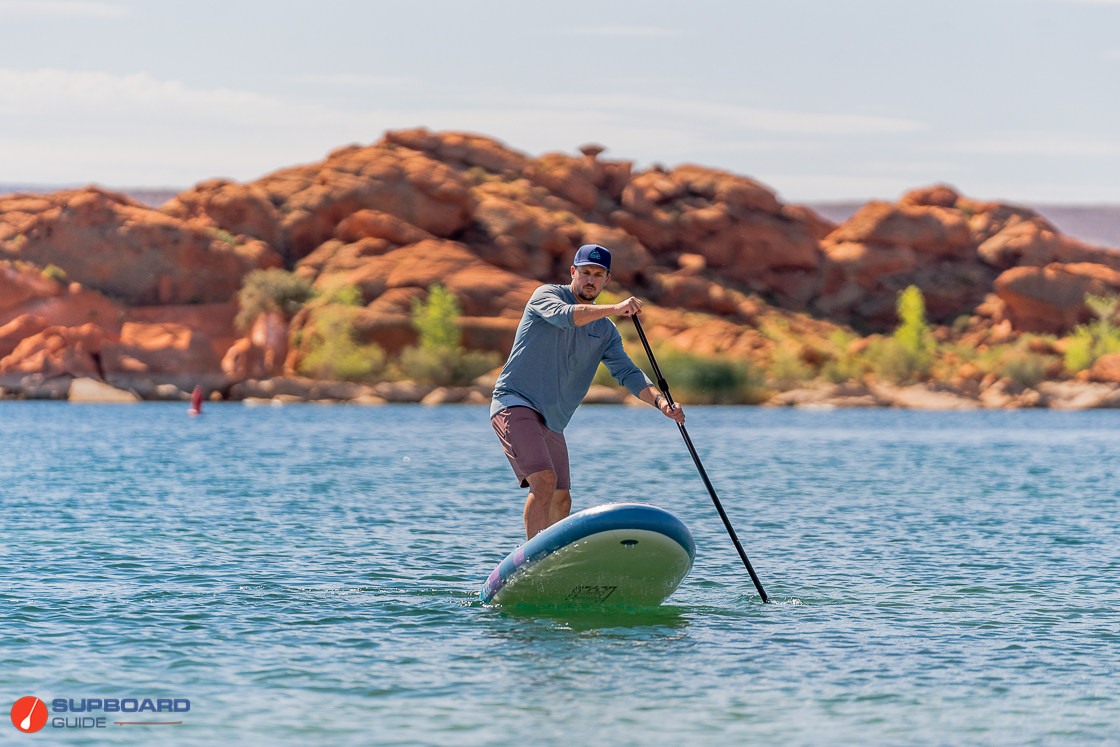

So all in all, the Glide 02 Retro 3.0 offers as much stability as many 34” wide boards that we have paddled. The only time you notice otherwise is if you walk right back to crank a pivot turn, when suddenly you’re stepping into a much narrower zone of the board, and all that width up front can no longer help you. For the large majority of people buying a general purpose all rounder board like this though, that’s unlikely to be a worry.
Glide claims that the board has a weight capacity of 400 lbs. It may well be that you could load up 400 lbs onto this board. Technically it has enough flotation to support that much weight without sinking. However, potential weight-carrying ability and stability are two very different things. The board most certainly wouldn’t be suitable for a 400 lb paddler. We’d recommend it for beginners up to around 220lbs, or paddlers with a bit more experience up to 240 lbs as a general purpose all rounder.
Speed Test: 8.7/10
| Board | |
| Sprint Speed: | 4.9 MPH |
| Average Cruising Speed: | 3.6 MPH |
To obtain our speed test results, we use a Speed Coach SUP 2 device from NK Sports. This gives us accurate real-time readings on how fast we are paddling and our stroke rates. For the sprint speed, we go hard for 10-15 seconds and then record our average speed. For the casual test, we paddle at 35-40 strokes per minute at what feels like a natural comfortable pace, and then check the average speed.
Again, the Glide O2 Retro 3.0 performed better than we were expecting. Wide boards aren’t generally fast since the extra width generates so much drag. But there are a few subtle things going on with this clever design that result in the board turning in quite a sprightly performance.
First and foremost, Glide’s extremely rigid new construction technique, light weight and ability to be inflated to a high pressure all combine positively to help the board hold its speed. It’s always easier to go fast on a board that feels stiff and responsive on the water.
Secondly, the pulled-in tail shape plays its part in reducing the drag factor; it’s very noticeable that the board leaves surprisingly little wake for such a big board.
Thirdly, the extremely good tracking of the board (discussed in the next section) ensures that the power you’re putting into your stroke is primarily driving the board forward.
The result is a board that can actually hold a decent pace on flat water. For sure, the extra width means it’s that bit harder to get your paddle properly vertical for maximum efficiency in your stroke, but overall we were pleasantly impressed with the speed that the Glide O2 Retro 3.0 could deliver. Some wider boards simply don’t want to go fast, end of story. You can get speed out of them if you put in the effort, but the second you let up, the board decelerates noticeably. Whereas the Retro gives you that feeling that it’s up for it, and happy to keep going.
Things change pretty quickly though if there’s any significant chop, whereupon the wide low nose does very much put the brakes on. There’s not enough nose rocker to generate sufficient clearance, so basically you hit everything in your path. So this wouldn’t be a board we’d necessarily recommend for paddling significant distances over open water. You can stand a bit further back to lift the nose slightly, but fundamentally this is a board happiest on fairly flat water.
Tracking: 9.1/10
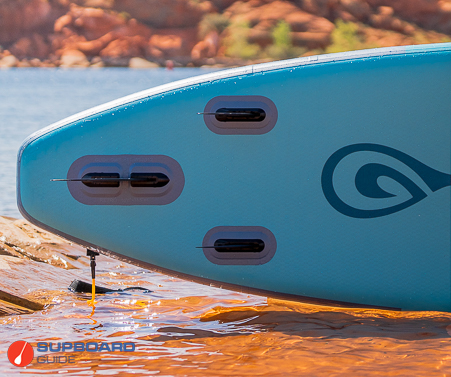
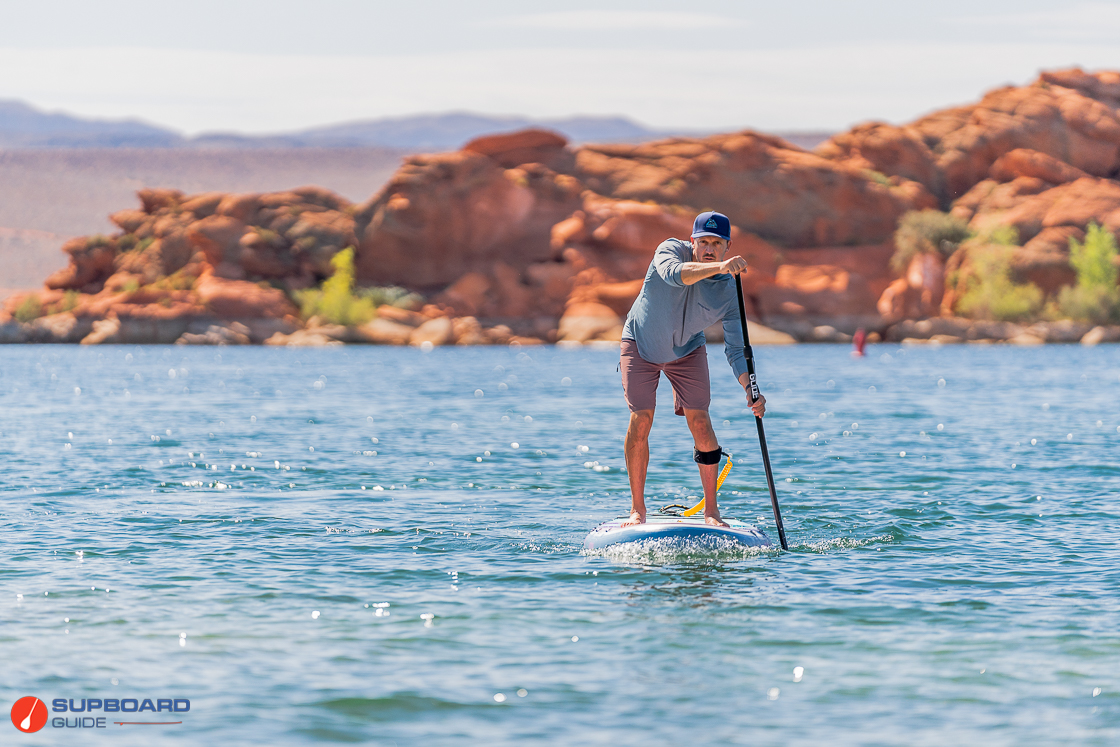
OK, we’re starting to sound a bit like a stuck record here, but guess what? Yes, once again the Glide O2 Retro 3.0 impressed us. Its tracking performance is really good for such a short, wide board.
Firstly, the new fin set-up has made a major difference. The previous model had just one fin, and a fairly swept-back one at that. Whereas the Retro 3.0 has three fairly significant fins, particularly the center fin which has a wide base and plenty of area. These fins do a great job at locking the board onto its course.
Having this directional stability at the back also allows the nose shape to work much better. Indeed, please forgive us if we geek out a little here, because there’s some genuinely interesting stuff going on with this design.
Board design is fascinating stuff, and we can talk about this all day. (Indeed, we do). If you’d like to really get up to speed on how it all works, what all the numbers mean then we’d really recommend you check out our vid where we explain all the parameters in great detail. We talk a lot about understanding plan shapes there, and how sometimes designers just throw the rule book out of the window. And how sometimes it works, sometimes it doesn’t.
The wide-nosed, pulled-in tail planshape of the Glide O2 Retro 3.0 has been around a long time in SUP, the first example we can think of dating back to 2012. However, it’s generally been used in search of extra maneuverability, and the pulling-in of the tail starts much earlier, not far behind the midpoint of the board. Whereas what Glide has done is subtly different, and the result is much more of the classic ‘torpedo’ shape. By stabilizing the tail area with the additional fins, the torpedo is now fully functional, and the increase in directional stability over the previous model is quite striking.

Look at the drawing above (a navy ‘Whitehead’ torpedo), and see how that drawn in tail and long straight forward section with the rounded nose is actually very similar to the plan shape of the Glide O2 Retro 3.0. This is a very stable shape through the water. And that’s what it feels like when you’re paddling the Retro.
Ok, geeking over – what we’re basically trying to say is that damn, this board holds its line well!
Maneuverability: 8.8/10
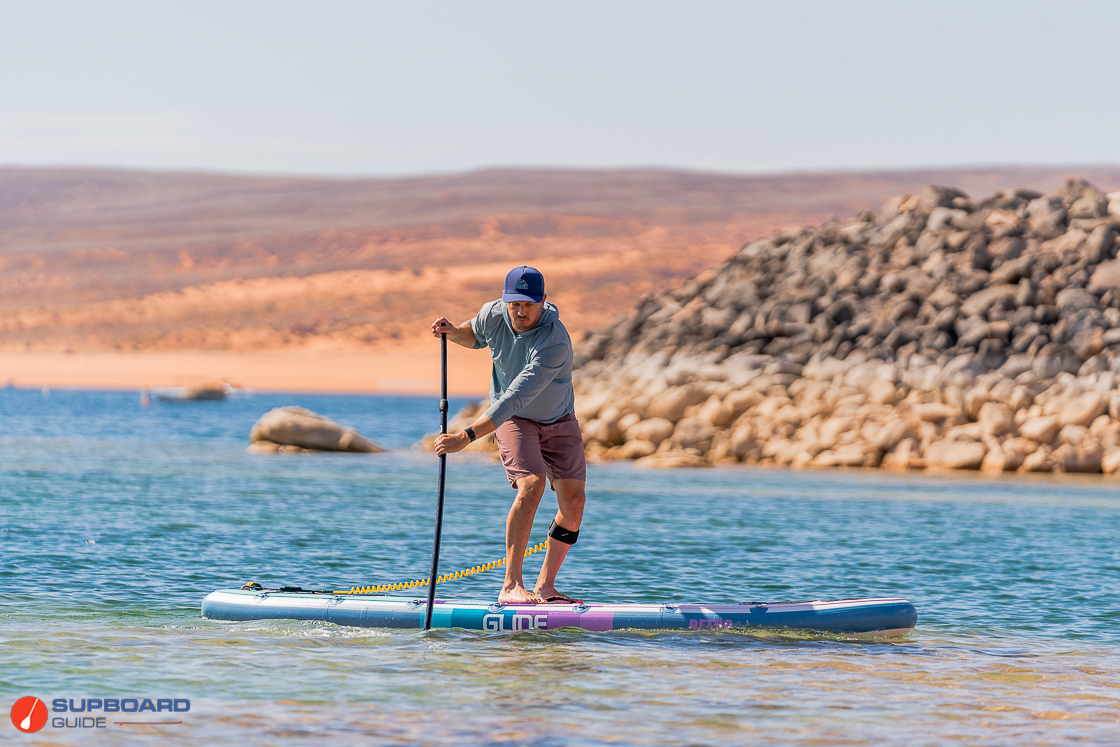
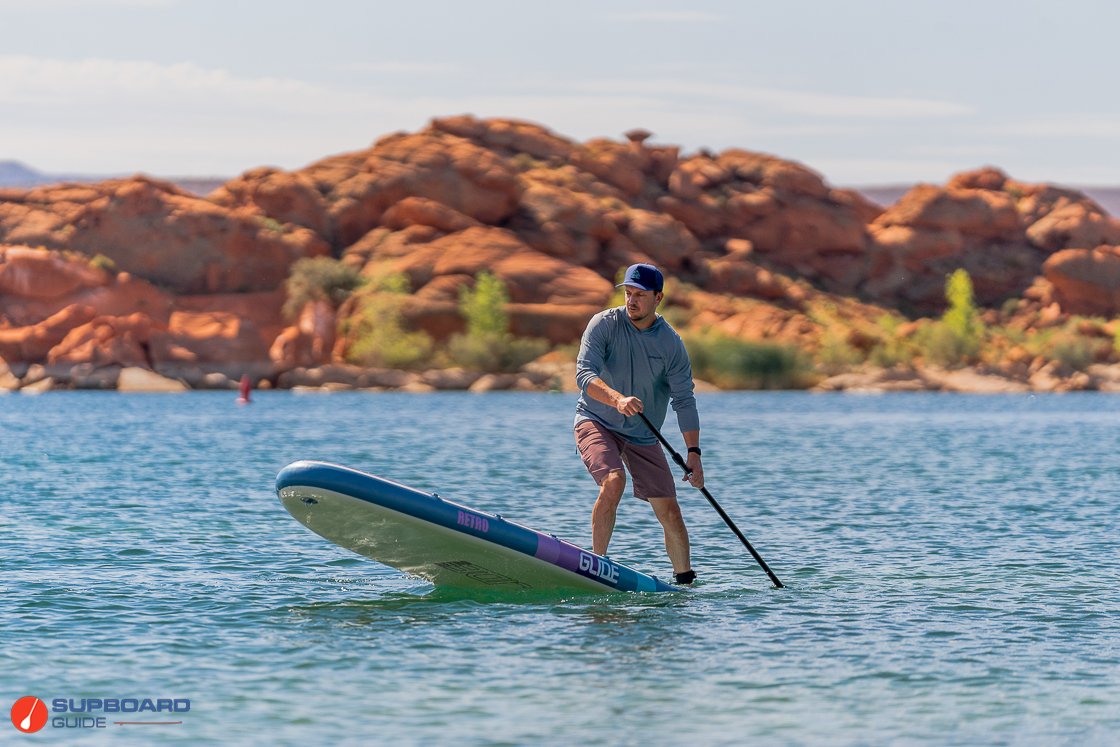
This is where we break the pattern. Which may come as a surprise if you’ve jumped straight into this section of the review, expecting us to be enthusing about how maneuverable the Glide O2 Retro 3.0 is thanks to that skinny little tail. Not so. This board doesn’t actually want to turn very much at all. Everything we enthused about in the Tracking section now comes back to work against the board when it comes to turning.
Fortunately, it doesn’t really matter too much, as you’re almost certainly not buying a board like this for surfing or slalom racing. It does of course still turn just fine, it simply takes a few more strokes and a bit more effort to get it to go round.
Be aware that when you step back to the tail in order to pivot turn, the board suddenly feels a whole lot less stable when you get into the narrower bit. And there is a lot of swing weight up there in the nose due to all that volume up front.
Construction Quality: 9.4/10
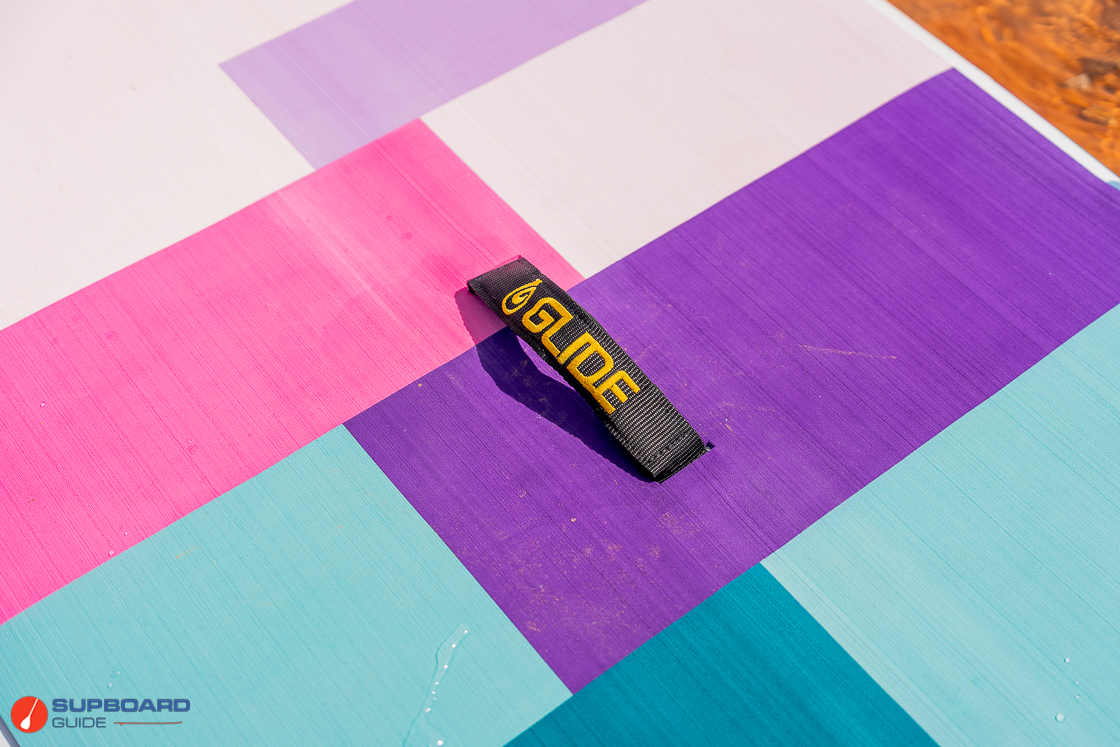
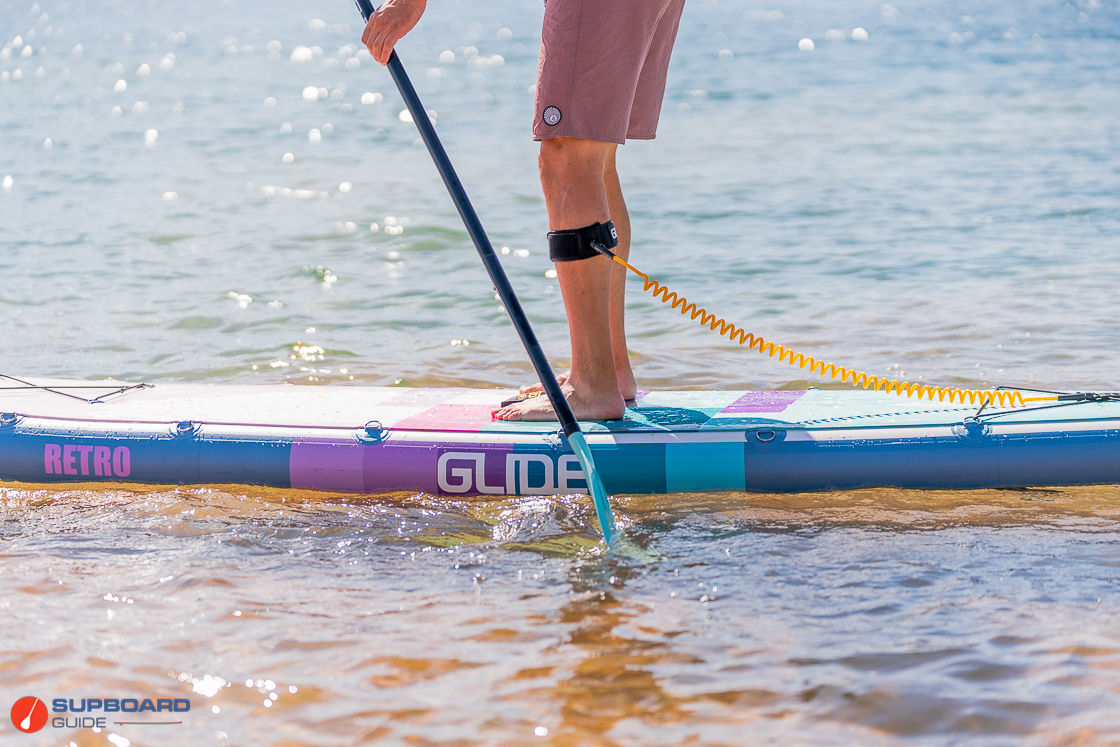
This is where we find the biggest changes in the 3.0 version of the Glide O2 Retro. Glide have moved to a new construction method with their 3.0 series, and are clearly very pleased with what they’ve achieved, as they’re backing it with a 5-year warranty.
The heart of the board is Glide’s ‘Aeromatrix Elite’ cross-woven dropstitch core. Woven fabric is lighter and more rigid than the knitted fabric used on lower-cost boards, and we pretty much always notice a significant increase in rigidity when we review boards using this technology.
The cross element (in the cross-woven) refers to the fact that the drop stitch yarns which connect the top and bottom of the board are offset and angled to create X shapes within the board. This approach has two benefits; it offers more strength than the standard V shape dropstitch, and also requires less threads per inch, thus reducing the overall board weight. X-woven fabric is still relatively new to the iSUP industry, and some brands have reported it being difficult to deploy, due to the complex alignment issues. However, Glide seems to have got it all sorted out pretty nicely.
The Retro 3.0 outer skin consists of a dual-layer 1300 denier PVC shell, with a high density scrim added between the layers. The fusion construction means that heat and pressure are used to mechanically bond the PVC layers together rather than utilizing glue. This fusion process is well-established and used by most leading brands nowadays.
The area of construction that – literally – makes or breaks an iSUP are the rails. This is where pretty much every iSUP will ultimately fail, so the better the rails are built, the better the board will be. Glide have gone for a three layer approach. An inner layer is heat welded to the top and bottom sections of the board, and then two outer layers of PVC are applied. Glide refers to this as their ‘ThermoFuse’ welded rail, and it certainly appears extremely tough and durable.
As well as backing their construction with a 10 year warranty, Glide also rates the O2 Retro 3.0 as good for up to 25 PSI of internal pressure. In reality, that may well be quite difficult to achieve unless you happen to have an industrial compressor to hand. Most iSUP pumps only go up to 20PSI, and getting to 25 PSI with a hand pump will take a fair bit of effort. You will almost certainly find that 20PSI is just fine. We have experimented in the past with higher pressures with some other brands and found that once you get above this the stiffness differences are pretty marginal.
Board Stiffness:
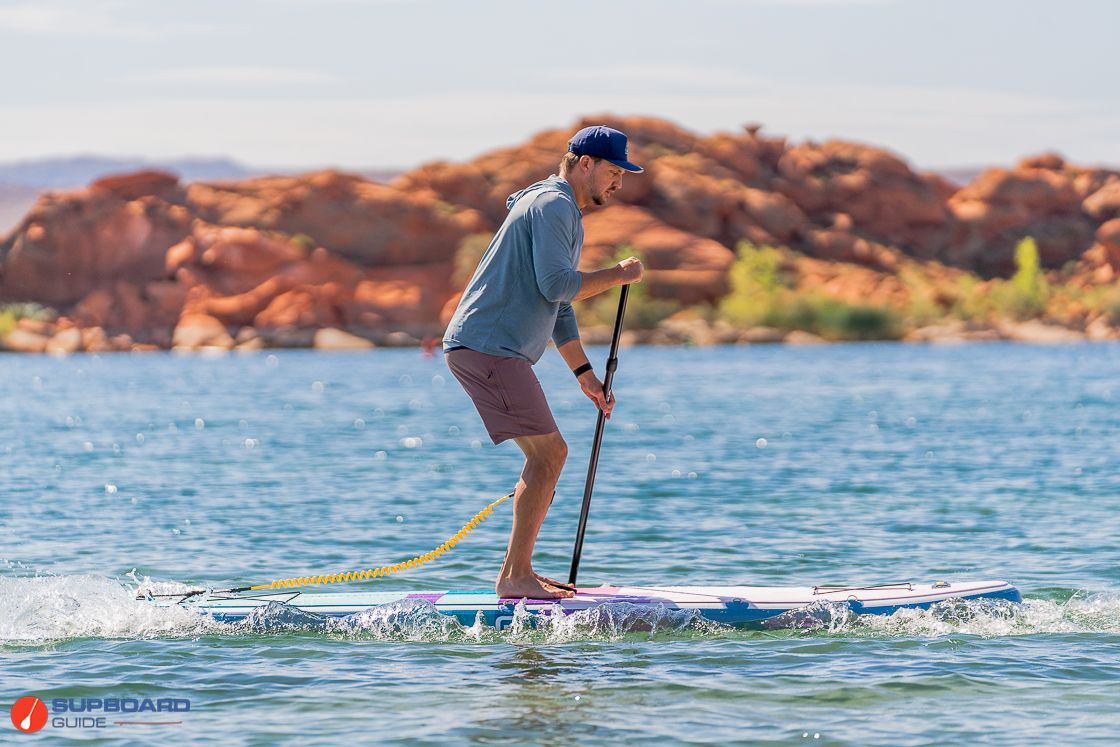
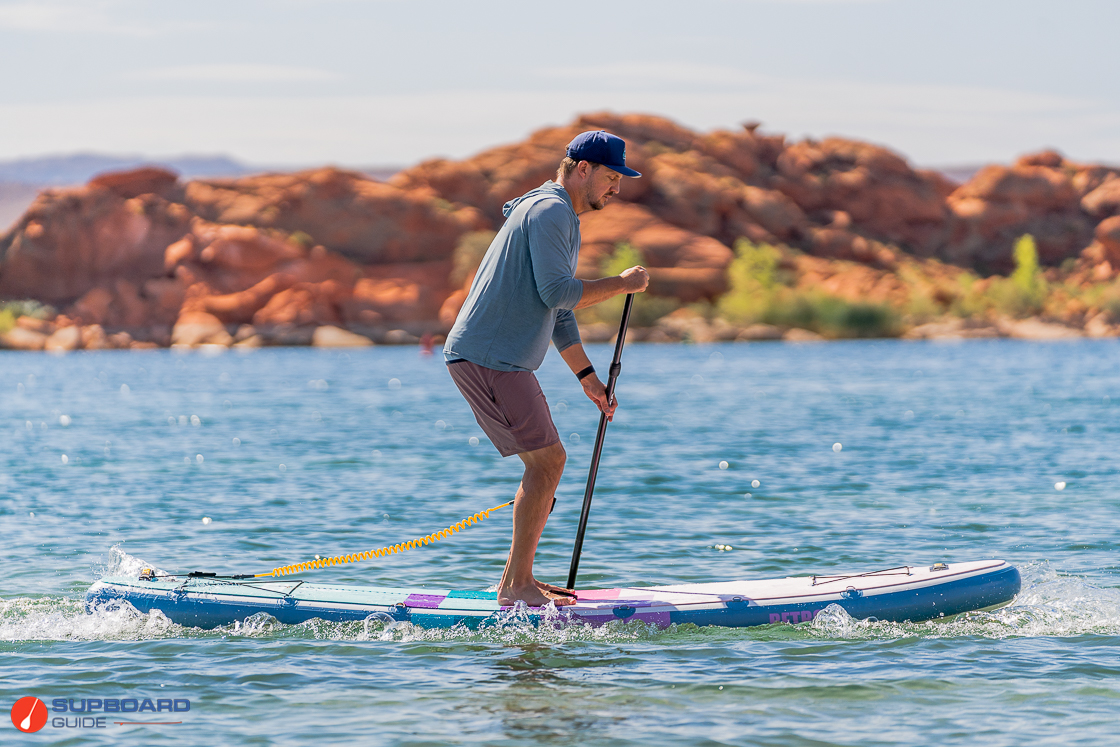
Stiffness Test: 1.13” Bend
At 20 PSI and with 170 pounds of weight in the standing area, the Glide O2 Retro 3.0 did very well in our 150-pound bend test. It’s not quite as stiff as the previous version, but is still a bit stiffer than average. The new Retro 3.0 is lighter than the previous version. It’s not always one-to-one, but generally lighter weight boards will be less rigid, but Glide has done a great job with the new cross-woven drop stitch core and triple-layer rails to make the O2 Retro 3.0 lighter with very minimal loss of rigidity.
On the new Retro still feels incredibly stiff while paddling. You can make it bounce a little when jumping on the board, but it feels completely rigid while paddling normally, and even in choppy conditions. Unless you have the previous version and the new 3.0 Retro side by side, I don’t think you are going to notice any difference in stiffness unless you are bouncing on them. There is a bit more bounce in the new Retro 3.0, but that’s the only time I felt it. Otherwise, it’s extremely stiff while paddling.

To ascertain the rigidity of each board we review, we use our own specific laboratory bend test process. The board is inflated to its maximum recommended PSI and then placed across two sawhorses positioned exactly 7 feet apart. We then measure the distance from the middle of the board to the floor. Then, we place a 150 lb weight on the middle top of the SUP, and measure the distance to the floor again. The difference between the two measurements shows the deflection, or ‘sag’, that the board has experienced due to the added weight. We have been reviewing the stiffness of boards using this technique since 2021 and while it isn’t an exact replication of the weight distortion that occurs when a rider stands on a SUP board in the water, it still gives a very useful comparative tool in determining the stiffness of the board’s construction process.
Features/Accessory Review: 9.0/10
Features:

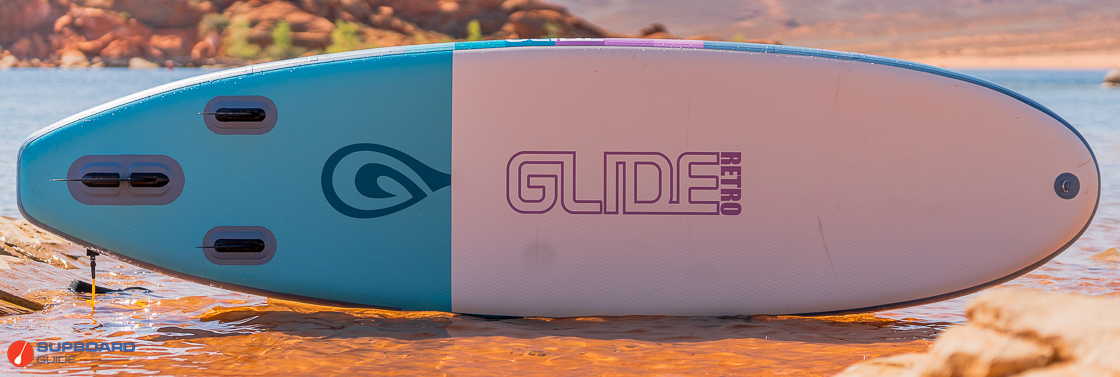
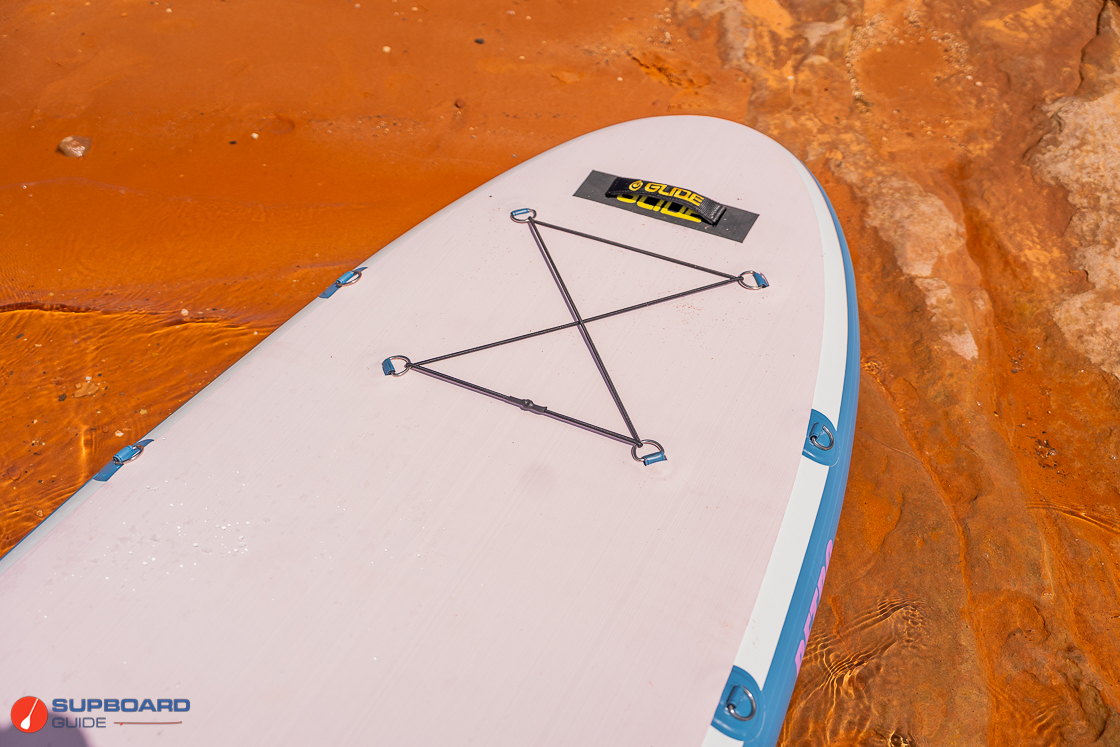
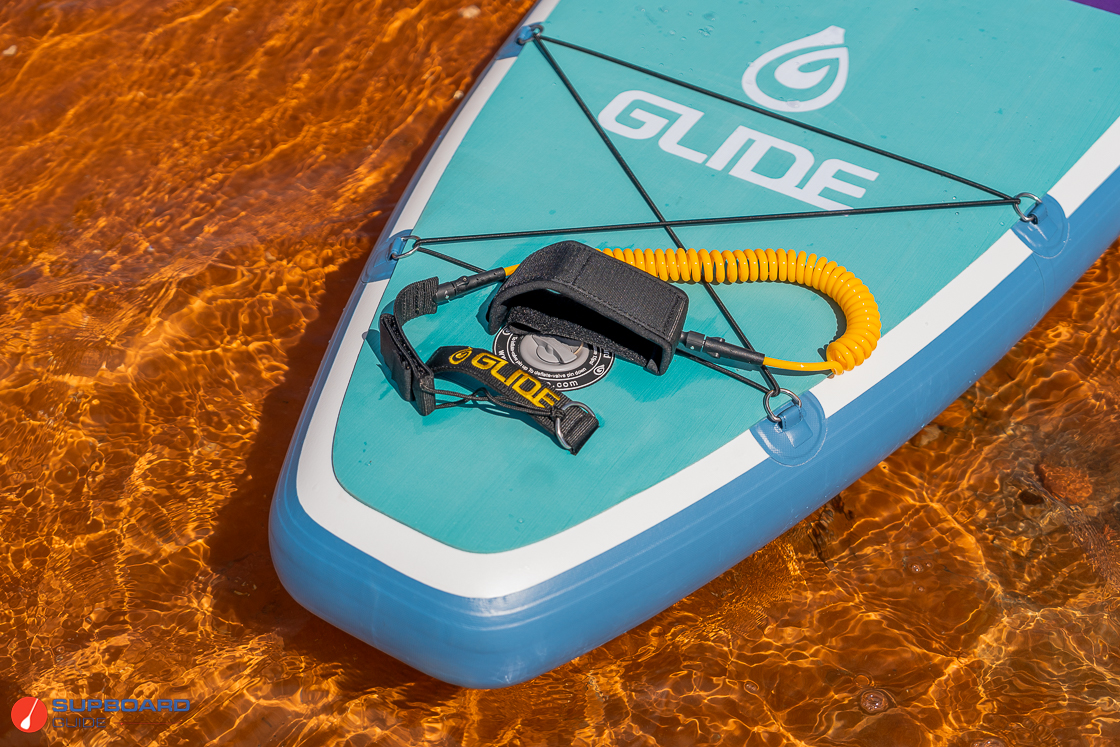
The Glide O2 Retro 3.0 has a few changes in the fittings and fixing department. We’re really pleased to see that it continues to boast a full sized deckpad, extending right to the very end of the nose and tail so you can make maximum use of the deck space, should you require. (The central carrying handle is lightweight and non-intrusive enough that you could lay on the board for yoga moves.) Big thumbs-up to Glide for their bright fun color schemes, incidentally. We’ve also been using a Retro 3.0 with the yellow color scheme and it’s great being on the brightest, cheeriest board on the water!
In addition to the 4-point nose bungee, Glide has now added a 4-point tail bungee. Both are fine for securing small items, but if you did want to carry more, then you’ve got a whole lot of other fixing points to choose from. Glide have approached the issue of accessorizing the O2 Retro 3.0 in an extremely businesslike fashion. Whereas other brands have specific fixing points for specific roles, Glide has just gone heavy on the steel D Rings. There are no less than 19 of them on the deck of this board! And it’s a neat approach; you can attach pretty much anything to a D Ring. Well, anything except action camera mounts. That’s something it would be nice to see on this board, seeing as it’s such a versatile craft. A point for Glide to consider for the Retro 4.0, perhaps.
Note that while the D Rings are ideally positioned for use with an over-the-shoulder carry strap, the board doesn’t come with one as standard.
On the underside of the board is yet another D Ring, as a towing point under the nose. (This may seem a minor thing but actually, if you ever need to tow the board behind another craft, you’ll find this extraordinarily useful).
At the other end of the underside are the finboxes; the new three-fin configuration being another point of difference over the previous version of the O2 Retro. Glide has gone with the split-US fin box for the center fin, which makes the board far easier to roll up for transportation. We’re always happy to see a US fin box being used, as it means you have a huge array of fin options available that can be used on the board. The proprietary fin box systems used by so many brands may save weight and cost but if you lose your fin, you’re potentially in a lot of difficulty. Whereas you can get another US-compatible fin pretty much anywhere in the world. (US means ‘Universal Standard’, incidentally. It’s not anything to do with the United States!).
The fin itself is a large 9” dolphin fin, with plenty of directional stability. The side fins are click-in fins, each 4.5” and again quite substantial in area. As discussed elsewhere in this review, they definitely add to the tracking performance of the board, but take a toll on the maneuverability. Could you paddle the board without them? Absolutely. Removing them will reduce the stability and tracking only a little, but make turning the board significantly easier. Alternatively (and a great idea if you’re paddling in shallow water), you could remove the center fin and just run the board on the two side fins. So it’s actually pretty cool having these three different configuration options (3, 2 or 1) to experiment with.
Included Accessories: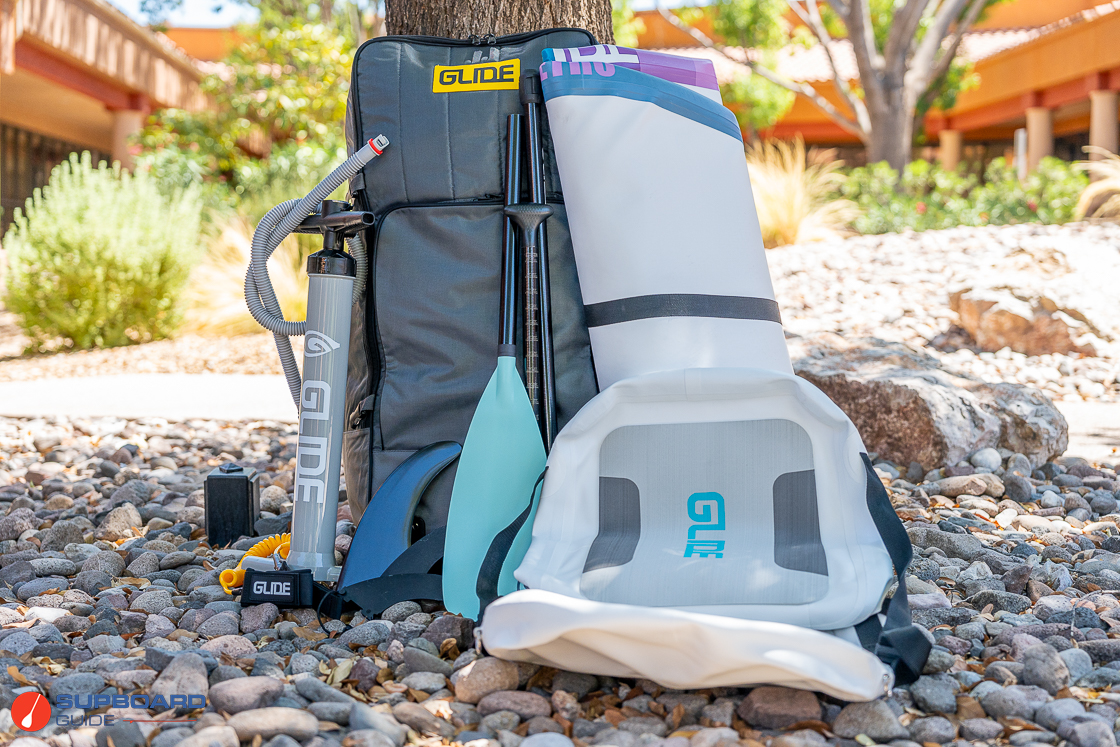
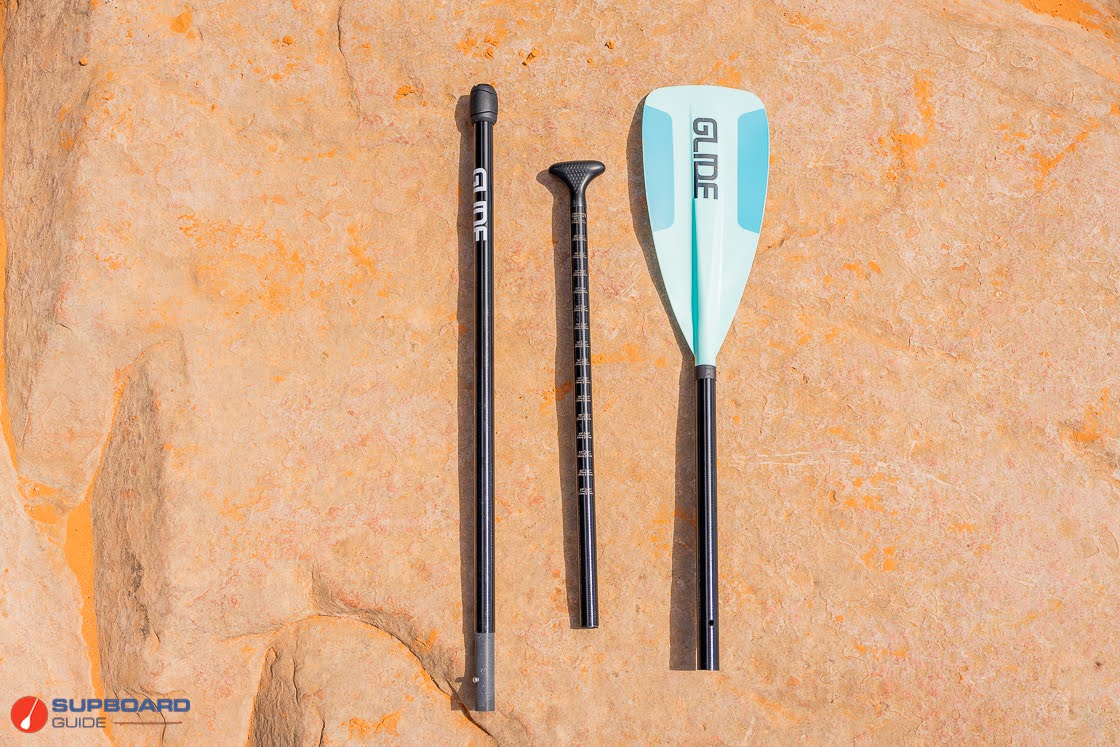
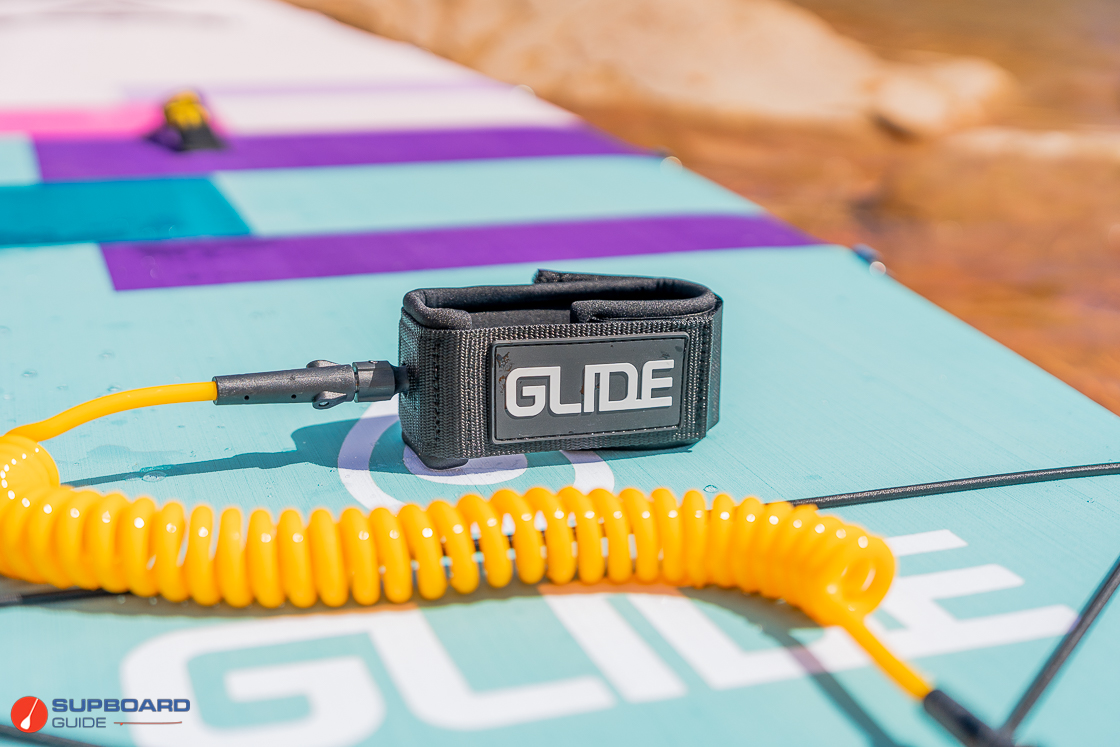
This is another area where the O2 Retro package has been upgraded. The 3 piece paddle has a composite shaft (fiberglass with some additional carbon cloth), and the adjustment system utilizes a clip pin, simple but effective and hard to break. As before, the paddle can be converted to a kayak paddle if you purchase the additional blade section.
The paddle blade is built of a reinforced nylon material. It has a modern profile, and a small degree of flex, giving comfortably smooth performance.
The hand pump offers double action (inflating both on the up stroke and down stroke), or you can upgrade to the excellent OutdoorMaster Shark II electric pump for an extra $109 at checkout.
The Airthrone inflatable kayak seat is pretty cool. We’ve seen a ton of different kayak seats this year, and it’s not really a thing we were expecting to see a whole lot of variation in. However, Glide has definitely gone their own way with the Airthrone, and it puts you considerably higher off the deck than most others. The back of the seat has a small pocket and a webbing strap for attaching water bottles and the like. The seat has fixings on each corner, and you can position it pretty much wherever you like on the board, as there are so many D Ring options. If you’re going to be using the board a lot in kayaking mode then you would be well advised to buy (or create) a footrest which can be secured between any of the forward D Ring pairs, and will make your kayaking experience a whole lot more ergonomic.
However, we’re a little confused by Glide’s thinking with regard to the kayak option for the Retro 3.0. It seems a bit ‘halfway house’ to include this excellent kayak seat ($149 if bought separately) but not the extra kayak blade ($55). The seat on its own is pretty useless without the blade – it would probably actually make more sense to include the blade but not the seat, and drop the price another $100. Or include both – or neither. So for this reason we haven’t discussed the performance of the board in kayak mode in this review, because it isn’t something that’s actually an option with the standard package.
Summary Review of the Glide O2 Retro 3.0
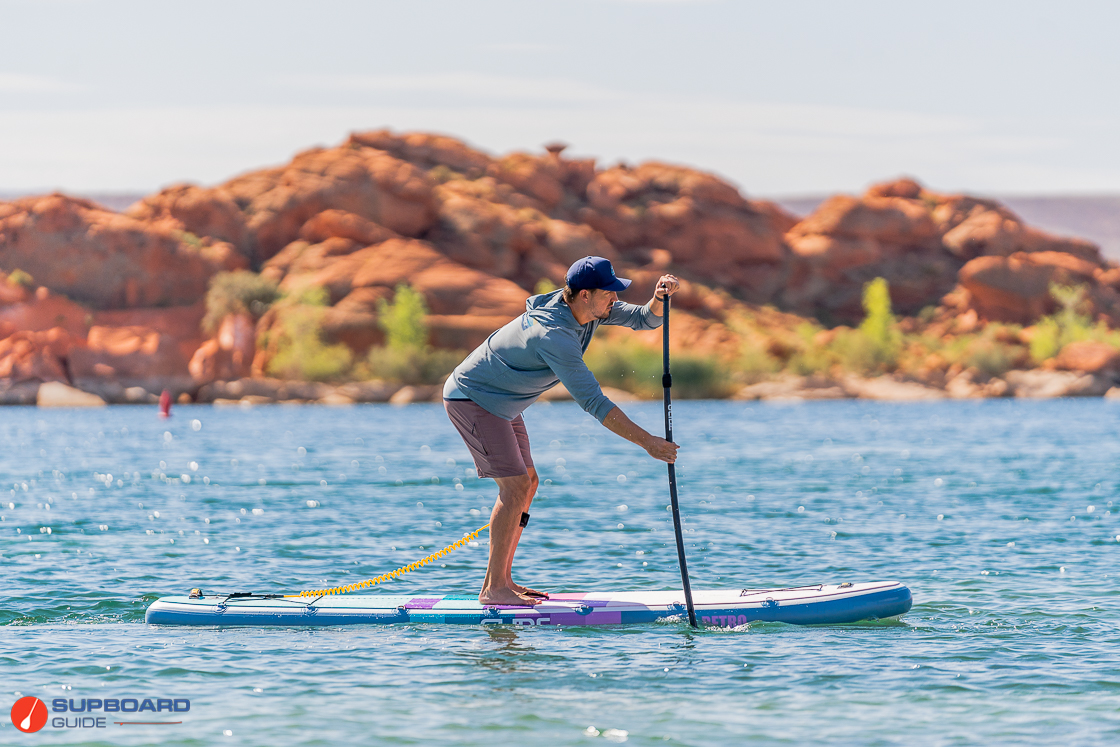
Glide have done a great job with this upgrade of their O2 Retro. The lighter feel and rigidity of the new construction has improved the performance of the board, making it a very nice platform for general paddling, with a light and purposeful feel. The additional fins give a wider range of configuration options, along with even better tracking and greater stability.
There are of course many boards with great stability. However, the Glide O2 Retro still retains that smaller, lighter feel despite its extra width, which sets it apart from the crowd in this area of the market. We see this board as being of particular appeal to larger paddlers who need stability but don’t want some great ‘aircraft carrier’ of a board. Alternatively, that fabulous stability could be put to good use for fishing, cargo carrying, using the board for yoga or exercise; whatever you want. The excellent set of fixing points for accessories adds further to its all-round appeal, and you’ve also got the kayak option if you splash out on the additional paddle blade.
Happy paddling! We hope you enjoyed this review of the Glide O2 Retro 3.0. If you have any questions or comments please leave us a comment below!
SupBoardGuide
Latest posts by SupBoardGuide (see all)
- Best Paddle Boards for Large Paddlers, 2025 - April 1, 2025
- Best Paddle Boards for Beginners, 2025 - March 27, 2025
- Best Multi-Person Party SUPs (2025) - February 25, 2025

